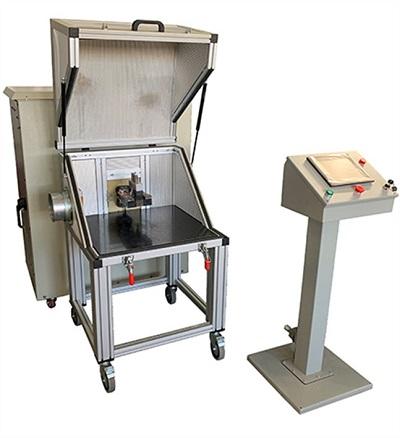- FMA
- The Fabricator
- FABTECH
- Canadian Metalworking
Categories
- Additive Manufacturing
- Aluminum Welding
- Arc Welding
- Assembly and Joining
- Automation and Robotics
- Bending and Forming
- Consumables
- Cutting and Weld Prep
- Electric Vehicles
- En Español
- Finishing
- Hydroforming
- Laser Cutting
- Laser Welding
- Machining
- Manufacturing Software
- Materials Handling
- Metals/Materials
- Oxyfuel Cutting
- Plasma Cutting
- Power Tools
- Punching and Other Holemaking
- Roll Forming
- Safety
- Sawing
- Shearing
- Shop Management
- Testing and Measuring
- Tube and Pipe Fabrication
- Tube and Pipe Production
- Waterjet Cutting
Industry Directory
Webcasts
Podcasts
FAB 40
Advertise
Subscribe
Account Login
Search
Impact welding equipment developed at Ohio State debuts at Tri-Rivers Career Center
- April 22, 2019
- News Release
- Aluminum Welding
A novel manufacturing method has proven capable of bonding dissimilar metal pairs, including aluminum to steel and titanium to steel, as well as many other advanced alloys. This new welding technology allows for lightweighting by multimaterial design and is an alternative to welding by melting.
Dr. Glenn Daehn, Mars G. Fontana professor of metallurgical engineering with The Ohio State University’s Department of Materials Science and Engineering, and Anupam Vivek, research scientist with the Department of Materials Science and Engineering, invented the manufacturing process, called vaporizing foil actuator welding (VFAW).
In this technique, electrical energy stored in a capacitor bank is released through a switched circuit that contains a thin metal conductor. Driven by a high-energy deposition rate, the conductor vaporizes and produces a high-pressure pulse that drives a flyer into a target at a high rate of speed, whereby an impact weld between dissimilar materials is created.
“This method offers the ability for vehicle designers to use the most appropriate material in specific locations on the vehicle body and provides strong, fastener-free joints between them,” said Daehn. “In order to bring this to broad use, this technology is now being deployed in simple-to-use prototype systems.”
Ohio State recently delivered the first prototype VFAW system to Tri-Rivers Career Center, which offers welding training at its RAMTEC robotics and advanced manufacturing training facility. Ohio State and RAMTEC are working with Ohio-based machine builder Coldwater Machine, a Lincoln Electric Automation company, to deliver equipment based on this emerging technology, made possible by a grant from the Ohio Development Services Agency (ODSA).
subscribe now

The Fabricator is North America's leading magazine for the metal forming and fabricating industry. The magazine delivers the news, technical articles, and case histories that enable fabricators to do their jobs more efficiently. The Fabricator has served the industry since 1970.
start your free subscription- Stay connected from anywhere

Easily access valuable industry resources now with full access to the digital edition of The Fabricator.

Easily access valuable industry resources now with full access to the digital edition of The Welder.

Easily access valuable industry resources now with full access to the digital edition of The Tube and Pipe Journal.
- Podcasting
- Podcast:
- The Fabricator Podcast
- Published:
- 04/16/2024
- Running Time:
- 63:29
In this episode of The Fabricator Podcast, Caleb Chamberlain, co-founder and CEO of OSH Cut, discusses his company’s...
- Industry Events
16th Annual Safety Conference
- April 30 - May 1, 2024
- Elgin,
Pipe and Tube Conference
- May 21 - 22, 2024
- Omaha, NE
World-Class Roll Forming Workshop
- June 5 - 6, 2024
- Louisville, KY
Advanced Laser Application Workshop
- June 25 - 27, 2024
- Novi, MI































